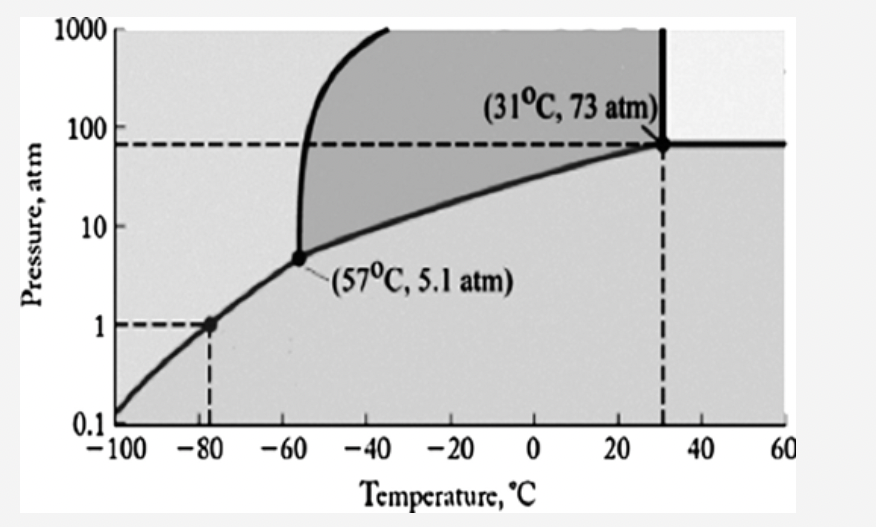
The phase diagram for carbon dioxide is shown below. What is the phase that exists at room temperature and pressure (22oC, 1 atm)?
Answers:
gas
liquid
solid
supercritical fluid
gas
For molecules, atoms, or ions with the same mass, which of the following force typically is the strongest intermolecular interaction?
Answers:
ion dipole
hydrogen bonding
dipole dipole
dispersion
ion-induced dipole
Ion dipole
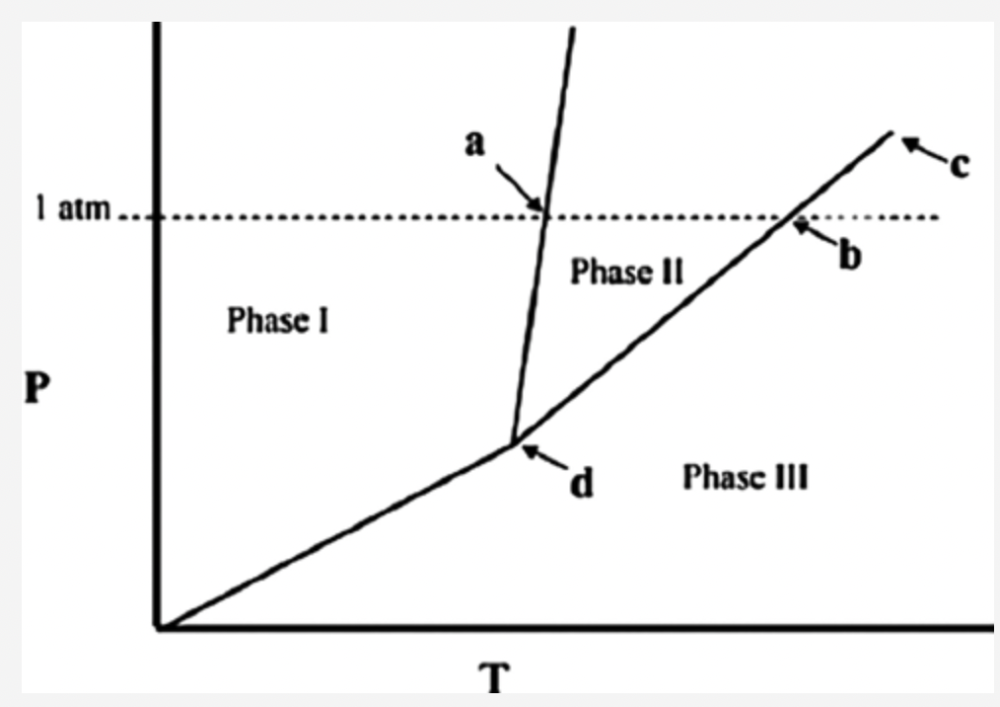
The temperature at point b in the phase diagram below is the ________
Answers:
critical point.
triple point.
transition point.
normal freezing point.
normal boiling point.
normal boiling point.
Which of the following polar compounds is likely to have the highest boiling point?
Answers:
CH3OCH3
CH3CH2OH
(CH3)2CO
H2CO CO
CH3CH2OH
Which molecule has the largest dipole?
Answers:
methane (CH4)
ammonia (NH3)
sulfur trioxide (SO3)
carbon dioxide (CO2)
ethylene (C2H4)
ammonia (NH3)
Which molecule does not exhibit hydrogen bonding?
Answers:
HF
CH3NH2
CH3OH
(CH3)3N
CH3CH2OH
(CH3)3N
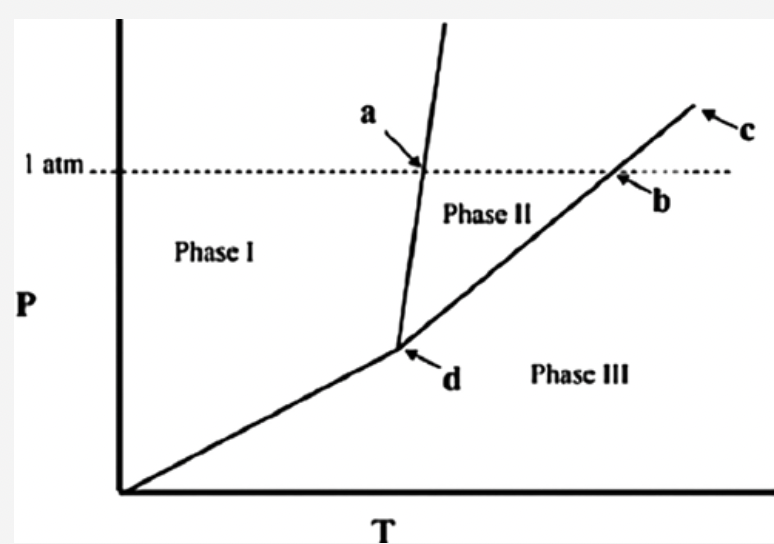
The temperature at point a in the phase diagram below is the ________
Answers:
critical point.
triple point.
transition point.
normal freezing point.
normal boiling point.
normal freezing point.
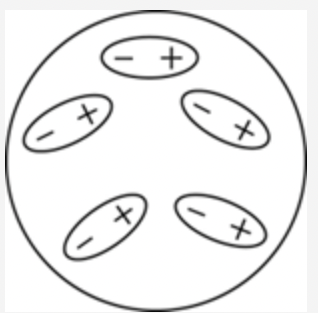
Which of the following diagrams best shows a set of polar molecules interacting through dipole–dipole interactions?

Based on their boiling points, which of the following compounds has the largest dipole dipole interaction?
Answers:
propane (231 K)
dimethyl ether (248 K)
acetonitrile (355 K)
methyl chloride (249 K)
butane (135 K)
acetonitrile (355 K)
Which of the following compounds is capable of dipole–dipole interactions?
Answers:
CH4
CO2
H2CO
SF6
NH4 +
H2CO
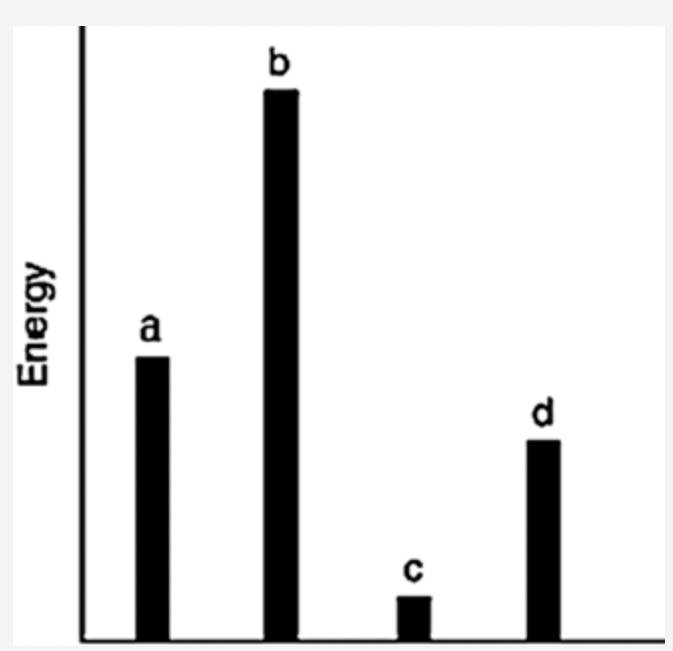
The relative energies (strengths) of the intermolecular forces between four different substances are shown in the figure below. Which substance has the highest boiling point?
Answers:
a
b
c
d
b
ndicate which of the following nonpolar compounds will have the lowest boiling point.
Answers:
CCl4
CI4
CF4
CH4
CBr4
CH4
Which of the following compounds will not possess dipole dipole interactions between its molecules?
Answers:
CF4
NH3
H2S
CH2F2
CH3Cl
CF4

The relative energies (strengths) of the intermolecular forces between four different substances are shown in the figure below. Which substance has the lowest boiling point?
Answers:
a
b
c
d
c
Indicate which of the following pairs of compounds is most likely to be miscible.
Answers:
H2O and CH3CH2CH2CH3
Br2 and HI
HF and CCl4
CCl4 and Br2
CCl4 and NH3
CCl4 and Br2
When sodium chloride dissolves in water, how do the water molecules orient around the ions?
Answers:
Water molecules are randomly oriented around the ions.
The hydrogen atoms point toward both the sodium and the chloride.
The oxygen atoms point toward both the sodium and the chloride.
Around sodium the hydrogen atoms point toward the sodium, and around chloride the oxygen atoms point toward the chloride.
Around sodium the oxygen atoms point toward the sodium, and around chloride the hydrogen atoms point toward the chloride.
Around sodium the oxygen atoms point toward the sodium, and around chloride the hydrogen atoms point toward the chloride.
Which statement about a hydrogen bond is not correct?
Answers:
"Hydrogen bonds involve hydrogen bonded to carbon, nitrogen, oxygen, or fluorine."
"In a hydrogen bond, the hydrogen atom on one molecule is attracted to unpaired electrons associated with nitrogen, oxygen, or fluorine on another molecule."
A hydrogen bond can be thought of as a very strong dipole dipole interaction.
The presence of hydrogen bonds leads to anomalously high boiling points for liquids.
Hydrogen bonds stabilize the double helix structure of DNA.
"Hydrogen bonds involve hydrogen bonded to carbon, nitrogen, oxygen, or fluorine."
Which statement about vapor pressure of a pure liquid is not correct?
Answers:
The vapor pressure is the pressure of the gas at a given temperature in equilibrium with its liquid phase.
The temperature at which the vapor pressure equals 760 torr is called the normal boiling point of the substance.
The vapor pressure increases with increasing temperature.
The vapor pressure increases with increasing surface area of the liquid.
Substances with weak intermolecular forces have high vapor pressures at a given temperature.
The vapor pressure increases with increasing surface area of the liquid.
Viscosity is a measure of a substance s ________
Answers:
ability to resist changes in its surface area.
surface tension.
resistance to flow.
compressibility. color.
resistance to flow.
At critical point ________________
Answers:
all the liquid has evaporated.
the densities of the solid and the liquid are the same.
the densities of the solid and the gas are the same.
the densities of the gas and the liquid are the same.
a critical mass has been reached.
he densities of the gas and the liquid are the same.
Which of the following molecules has the highest boiling point?
Answers:
CH4
SiH4
SnH4
GeH4
H2
SnH4
Which statement about vapor pressure of a pure liquid is not correct?
Answers:
The vapor pressure is the pressure of the gas at a given temperature in equilibrium with its liquid phase.
The temperature at which the vapor pressure equals 760 torr is called the normal boiling point of the substance.
The vapor pressure increases with increasing temperature.
The vapor pressure increases with increasing surface area of the liquid.
Substances with weak intermolecular forces have high vapor pressures at a given temperature.
The vapor pressure increases with increasing surface area of the liquid.

he temperature at point b in the phase diagram below is the ________
Answers:
critical point.
triple point.
transition point.
normal freezing point.
normal boiling point.
normal boiling point.
The vapor pressure of a liquid will increase if ________
Answers:
the temperature is increased.
the volume available to the gas phase is increased.
the volume of the liquid phase is increased.
the liquid is stirred.
the liquid is put in a container with a larger surface area.
the temperature is increased.

The phase diagram for carbon dioxide is shown below. What is the phase that exists at room temperature and pressure (22oC, 1 atm)?
Answers:
gas
liquid
solid
supercritical fluid
gas
Which of the following molecules will have the least interaction with a Li+ ion?
Answers:
water (H2O)
ethanol (CH3CH2OH)
chloroform (CHCl3)
ammonia (NH3)
pentane (C5H12)
pentane (C5H12)
Of all the noble gases, ________ has the weakest intermolecular force and hence the lowest boiling point.
Answers:
He
Ne
Ar
Kr
Xe
He
Which is the dominant interaction between acetone molecules, (CH3)2CO?
Answers:
ion ion
ion dipole
dipole dipole
hydrogen bonding
dispersion or London forces
dipole, dipole
Normal boiling points of branched alkane hydrocarbons generally are lower than for straight-chain hydrocarbons of the same molar mass because the straight-chain hydrocarbons ________
Answers:
have stronger dipole dipole interactions.
have many more electrons.
have more C H bonds.
have a larger surface area and come in closer contact with each other.
react with each other to form long chains.
have a larger surface area and come in closer contact with each other.
Which of the following non-polar molecules will have the highest boiling point?
Answers:
CO2
C6H6 (benzene)
C6F6 (hexafluorobenzene)
C2H2
CF4
C6F6 (hexafluorobenzene)
Which of the following molecules has the highest boiling point?
Answers:
CH4
SiH4
SnH4
GeH4
H2
SnH4
Which is the dominant interaction between oxygen and nitrogen molecules in air?
Answers:
ion ion
ion dipole
dipole dipole
hydrogen bonding
dispersion or London forces
dispersion or London forces
Gasoline is primarily a mixture of hydrocarbons and is sold with an octane rating that is based on a comparison with the combustion properties of isooctane. Gasoline usually contains an isomer of isooctane called tetramethylbutane (C8H18), which has an enthalpy of vaporization of 43.3 kJ/mol and a boiling point of 106.5°C. Determine the vapor pressure of tetramethylbutane on a very hot summer day when the temperature is 38°C.
Answers:
80.0 torr
36.7 torr
67.8 torr
47.9 torr
89.3 torr
36.7 torr
Which of the following compounds will not possess dipole dipole interactions between its molecules?
Answers:
CF4
NH3
H2S
CH2F2
CH3Cl
CF4

Which of the following substances is a solid at 25°C and 1 atm?
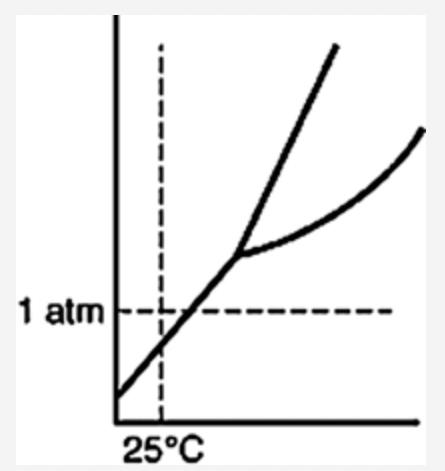
The smell of fresh-cut pine is due in part to a cyclic alkene called pinene. A graph of the natural logarithm of the vapor pressure of pinene vs. 1/temperature produces a straight line with a slope of -4936.37 K. What is the enthalpy of vaporization of pinene?
Answers:
+397 kJ/mol
39.7 kJ/mol
+39.7 kJ/mol
- 41.0 kJ/mol
+41.0 kJ/mol
+41.0 kJ/mol
Which of the following compounds is capable of hydrogen bonding?Which of the following compounds is capable of hydrogen bonding?Answers:
CH3OCH3
CH3COCH3
CH3CH2OH
H2CO
CH3F
CH3CH2OH
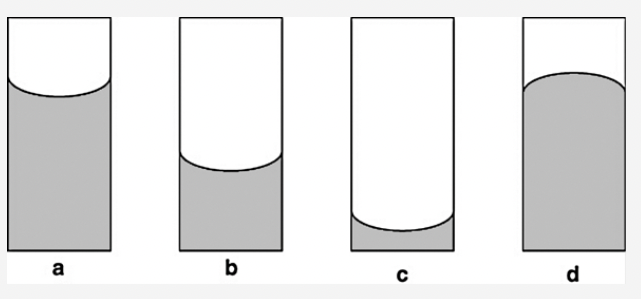
In which of the following diagrams are the cohesive interactions between molecules in the liquid greater than the adhesive forces between the liquid and the walls of the tube?
Answers:
a
b
c
d
d
Which of the following polar compounds is likely to have the highest boiling point?
Answers:
CH3OCH3
CH3CH2OH
(CH3)2CO
H2CO
CO
CH3CH2OH
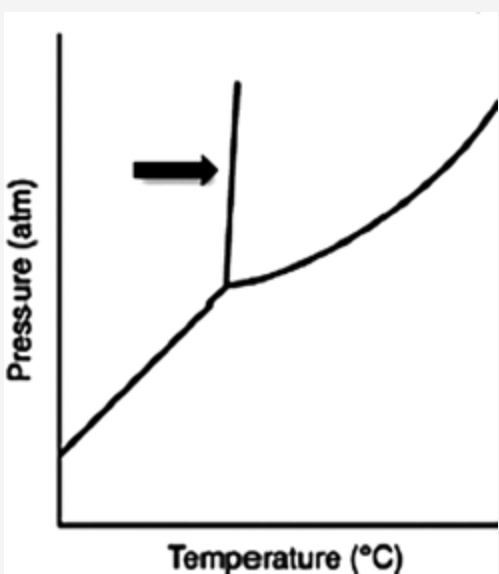
What does the line indicated by the arrow in the following phase diagram represent?
Answers:
solid–liquid boundary
solid–gas boundary
liquid–gas boundary
triple point
solid–solid boundary
solid–liquid boundary
Based on their boiling points, which of the following compounds has the largest dipole dipole interaction?
Answers:
propane (231 K)
dimethyl ether (248 K)
acetonitrile (355 K)
methyl chloride (249 K)
butane (135 K)
acetonitrile (355 K)
Which type of intermolecular interaction exists for all compounds?Answers:
ion ion
dipole dipole
dispersion
hydrogen bonding
dipole-induced dipole
dispersion
When sodium chloride dissolves in water, how do the water molecules orient around the ions?
Answers:
Water molecules are randomly oriented around the ions.
The hydrogen atoms point toward both the sodium and the chloride.
The oxygen atoms point toward both the sodium and the chloride.
Around sodium the hydrogen atoms point toward the sodium, and around chloride the oxygen atoms point toward the chloride.
Around sodium the oxygen atoms point toward the sodium, and around chloride the hydrogen atoms point toward the chloride.
Around sodium the oxygen atoms point toward the sodium, and around chloride the hydrogen atoms point toward the chloride.
Of all the noble gases, ________ has the weakest intermolecular force and hence the lowest boiling point.
Answers:
He
Ne
Ar
Kr
Xe
He

Which of the substances a–d in the following figure has the weakest intermolecular forces?
a
b
c
d
c
Which intermolecular force is caused by an instantaneous dipole generated by close contact with other atoms or molecules?
Answers:
ion ion
forces ion
dipole forces
hydrogen bonding
dipole dipole
forces dispersion forces
dispersion forces

The relative energies (strengths) of the intermolecular forces between four different substances are shown in the figure below. Which substance has the lowest boiling point?
a
b
c
d
c

Which of the following diagrams best shows a set of polar molecules interacting through dipole–dipole interactions?


What does the line indicated by the arrow in the following phase diagram represent?
Answers:
solid–liquid boundary
solid–gas boundary
liquid–gas boundary
triple point
solid–solid boundary
solid–liquid boundary
Which alkane compound has the lowest boiling point?
Answers:
C4H10
C5H12
C6H14
C7H16
C8H18
C4H10